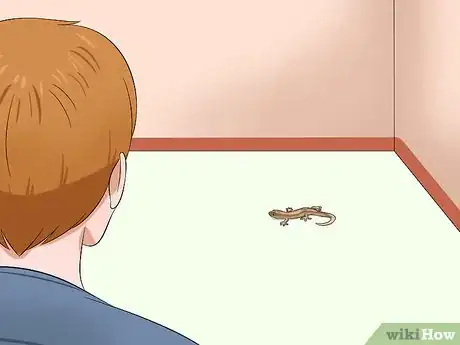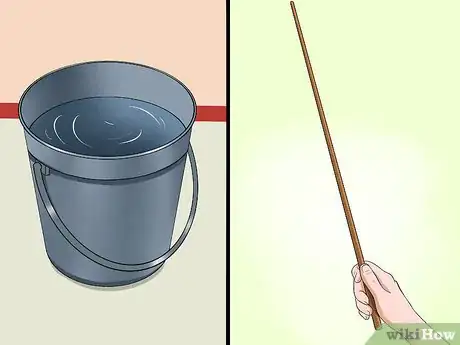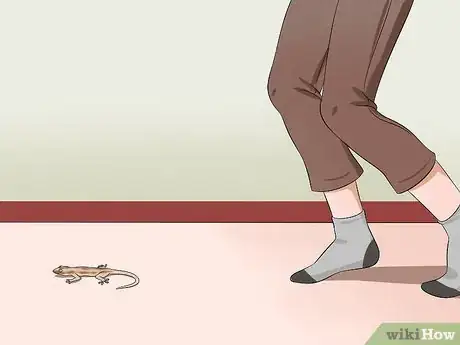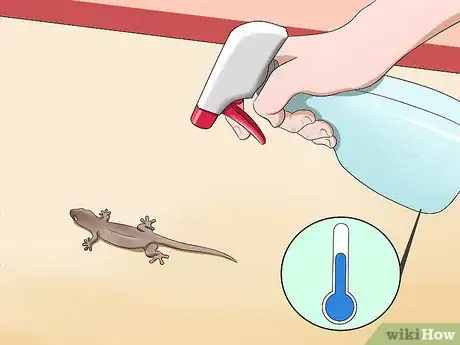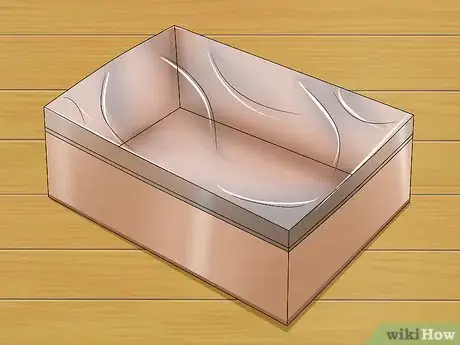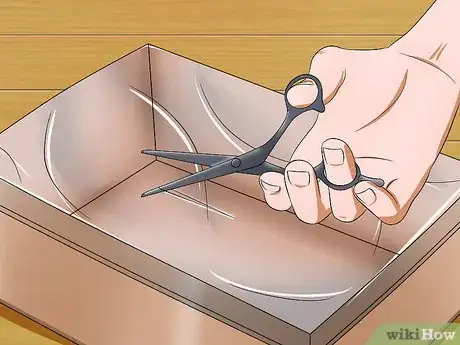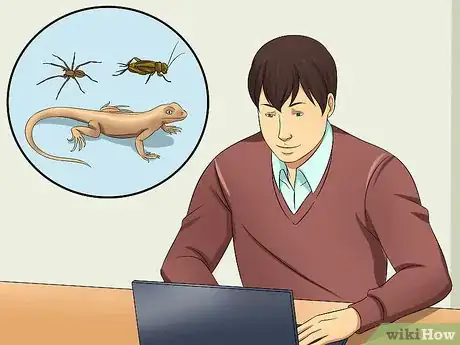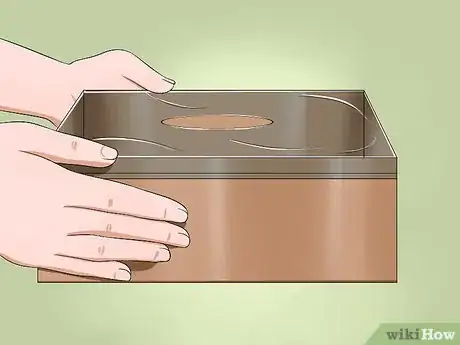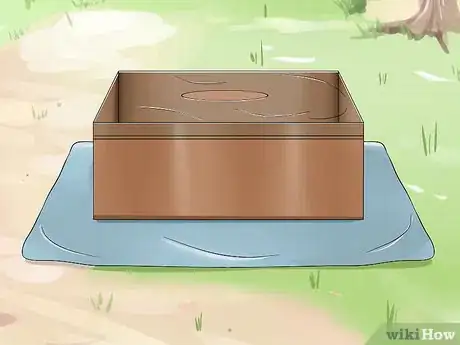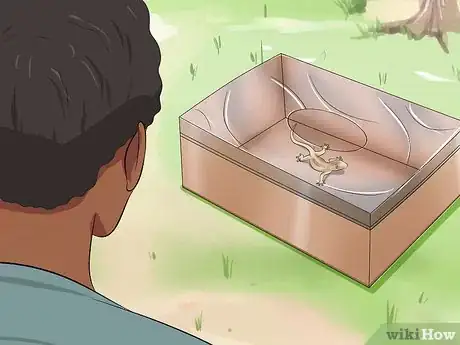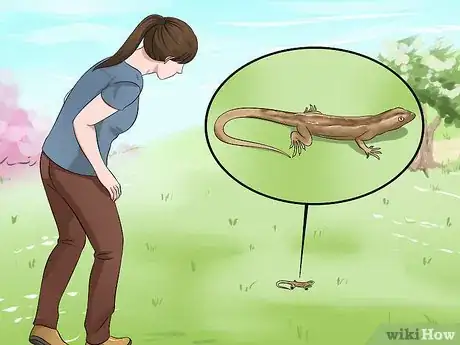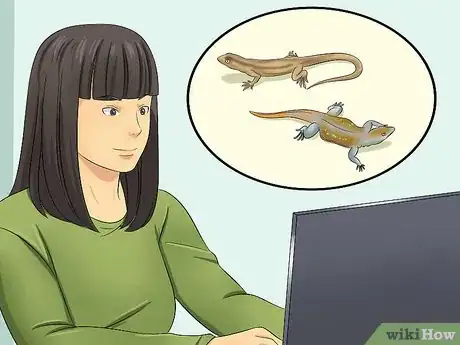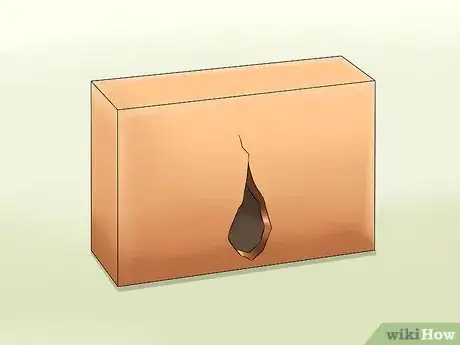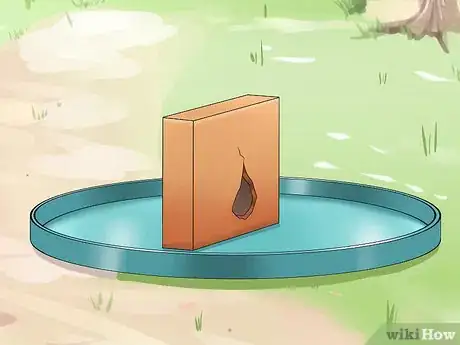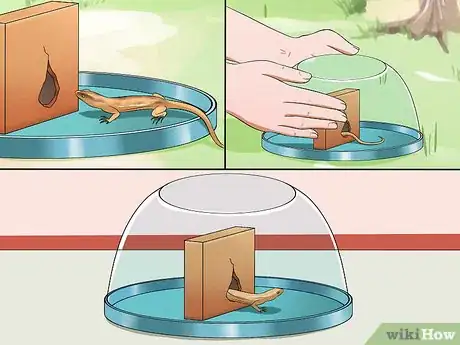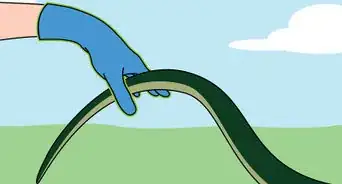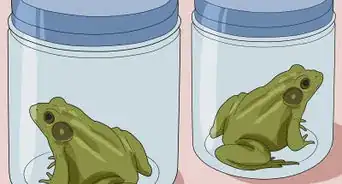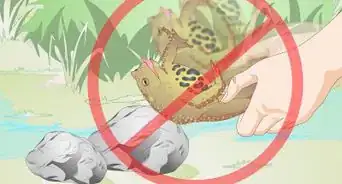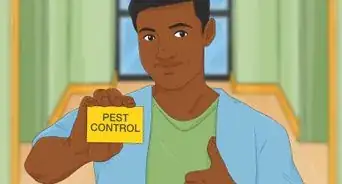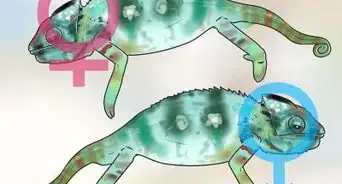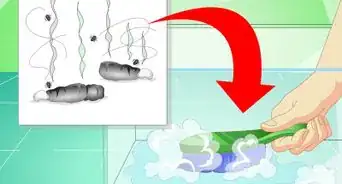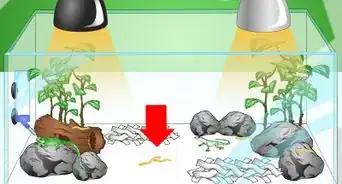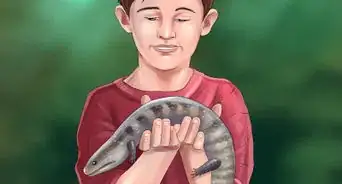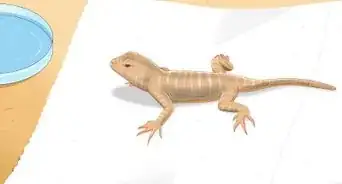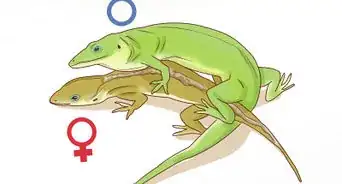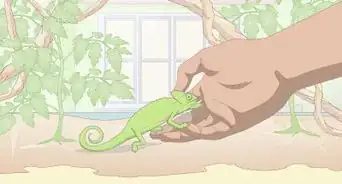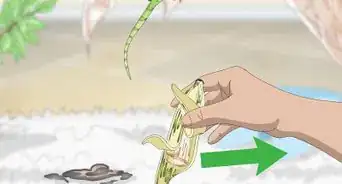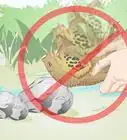This article was co-authored by Pippa Elliott, MRCVS. Dr. Elliott, BVMS, MRCVS is a veterinarian with over 30 years of experience in veterinary surgery and companion animal practice. She graduated from the University of Glasgow in 1987 with a degree in veterinary medicine and surgery. She has worked at the same animal clinic in her hometown for over 20 years.
This article has been viewed 310,044 times.
Maybe it's the new unwanted visitor in your house. Maybe you just want to have a "pet" for part of a day. It could be that you just want to see if there are any lizards around your yard. Whatever your reasons, there are ways to catch one of these quick little critters that don’t involve having to touch them directly.
Steps
Corralling the Lizard in Your Home
-
1Pinpoint the room it’s in. If the little critter is an unwanted guest in your house, knowing the room you see it in most often will help you catch it. Hopefully it’s the same room every time. As they’re creatures of habit, you could even get lucky enough to spot it in the same part of the room each time.
- Scope out the room for the cracks/crevices it could be coming in and out of. Catching it could require closing those while it’s loose in the room.
-
2Narrow down and close off the escape routes. Then you need to get yourself a bucket (or box) and a long stick – at least 3 feet long. Make sure the stick is not pointed.[1]
- Use multiple buckets (or boxes). Set up a blanket or three to block the escape routes between your buckets. Increasing the odds can only help your cause.
- Place the bucket(s) where you want the lizard to escape. Your best bet is to put them where the lizard has been previously escaping.
- Draw or paint a crack on the bottom of the bucket. As lizards love to hide in cracks, if it thinks it sees one it will be more likely to head there. Use a Sharpie or paint if you choose to draw/paint one.
- Be sure to dry the ink/paint. You want all chemical smells to dissipate as much as possible. You can even give it a light washing to help make it safer and less likely to cause the lizard to run away from it.
Advertisement -
3Approach your lizard silently and slowly. If you scare it, the whole process can get infinitely harder.
- Wear only socks. This way there’s no danger of a squeaky shoe, the click of a heel, etc.
-
4Spray the lizard with a mist of cold water to slow it down. Now use your stick to gently guide it into the bucket.
- Do not touch the lizard with your stick. You not only don’t want to hurt the little critter but it also won’t take much to get him running.
- Adjust to your lizard’s behavior. If it’s still not moving after you spray it with cold water, you can also gently place a bucket over it. Use a Manila envelope and slide it gently under the bucket to seal it. Then slowly turn the bucket over, keeping the Manila envelope securely over the bucket’s opening.
- Use your stick to tip the bucket upright. If your lizard runs quickly into a bucket, don’t waste time getting to the bucket to use your hand. This could be the difference between a captured lizard and a lizard once again on the loose.
Building a Lizard Trap
-
1Find the most odor-free box you have. Bad smells can keep the lizards away from your trap. Using cellophane, thoroughly cover the open end and secure it around the sides with odor-free tape.
-
2Cut a hole in the cellophane. Make sure it’s in the middle of the cellophane covering and be certain that it isn’t much bigger than your lizards will be. If it’s too big other critters you don’t want in there with the lizards could get in (e.g. bigger snakes).
- You can also use a glass pet terrarium if you have one and don’t mind cutting a hole in the screen top. This will also give you a 360-degree view of the inside of the box from a distance.
-
3Research the lizards in your area. This will tell you what your lizard likes to eat. Drop a few bugs from the pet shop inside.[2]
- Choose food carefully. For example, the western long tail lizards near Las Vegas feed on insects and spiders. You may not find the right type of spiders in the pet shop so relocating a spider from around the house to your trap could work. You could also try putting some fruit inside to attract flies and fruit flies that will also be enticing.
-
4Place the box where lizards hang out in your yard. If there is a ledge nearby, use it to your advantage. Lizards love the climb walls so this could be an extra-attractive location.
-
5Put a tarp beneath your lizard trap. If there’s moisture on the ground, this will help keep it dry.
-
6Come back periodically and see if you caught any lizards. If not, make sure you still have live bait inside. If you have…enjoy!
Attracting a Lizard for Trapping
-
1Watch your yard. If you see the little reptile you’d like to see up close and personal hanging out, keep track of where and when you see it. This will be important come hunting time. Just like the guys on the nature shows, you need to understand your quarry’s habits.
-
2Go online and research the types of lizards in your neighborhood. This will undoubtedly give you information on their favorite habitats, places to hide, etc. Then you can locate the spot the place in your yard most likely to attract one.
- Around Las Vegas, for example, the western long tailed lizard (WLTL) is abundant. A quick Internet search will give you a lot of vital, useful information.
- The WLTL likes to hide in the trees and exposed roots of the Creosote bush. Utilizing either a bush in or nearby your yard or even trying to get scrap Creosote bush roots to create a shelter in your yard is a great idea.
- WLTL also feed on insects and spiders, so relocating a spider to your Creosote trap or putting some fruit there to attract flies and fruit flies will also be enticing.
- If you live in Riverside or San Diego Counties in California the banded rock lizard (BRL) is a common site. The BRL eats ants, beetles flies, caterpillars, spiders, flower buds and blossoms.
- Being a flat lizard that likes to hide in and under boulders and rocks, creating a trap with these while providing abundant food is a great way to bring one of these guys into your yard or a convenient area nearby.
-
3Build a realistic habitat. You want to attract a lizard to the spot in your yard you’ve chosen. From your research you will find that small lizards like to hide in cracks. So get yourself some spare wood and build a miniature wall of sorts that has a good-sized gap in it for a lizard to hide in. You can also use cement and a mold if you have the materials more readily available.[3]
- Strictly follow your research here. Build the right kind of lizard trap and you’ll probably catch a lizard.
-
4Find a container larger than your wall/structure. Place the lid on the ground, interior facing up (exterior of lid facing down) and put your wall/structure on top of it. Secure your wall/structure to the lid (nails or screws are best as you can make them mostly chemical and odor free by boiling them in water).
- This may be difficult if you pile the wood or rocks to create openings to hide in (depending on your research). You will have to improvise with some glue, some nails, etc. Lizards like body-sized openings so as long as you can create these you have a great chance of catching one.[4]
-
5Spring your trap. Once you see the lizard has taken a liking to your structure, wait until he is inside the crack and put the bottom of the container over everything and affix it to the upside-down lid. Now you have yourself a lizard.
- A clear/transparent container works best. You can also buy a cheap opaque container at any hardware store and cut the bottom out of it. Be careful: if your wall is tall enough to be close to the height of the box, cutting out the bottom could allow your lizard to jump out.
Warnings
- If for some reason you do touch the lizard or decide to try and pick it up, be sure to wash your hands before and after.⧼thumbs_response⧽
- Small lizards do have teeth. Though they are very small and generally cannot break the skin, it can still hurt. Plus, the stress on you and the lizard is not good for either of you.⧼thumbs_response⧽
- Respect the lizard as you respect all other animals. If you aren't careful and gentle it may launch at you or bite you.⧼thumbs_response⧽
- Make sure the type of lizard will not hurt you before you try to catch it. Some lizards have very strong jaws and some are poisonous.⧼thumbs_response⧽
- Turtles, lizards, and various other reptiles are known to carry Salmonella bacteria. Be aware of your own risk.⧼thumbs_response⧽
- While a lot of lizards eat crickets there are many that do not. Be sure to research this before catching your new friend. For example, the horny toad (not a toad but a horned lizard from the southwest US) diet is primarily ants. They will eventually die if they are forced to eat mealworms or crickets as their only food and will be attracted to neither.⧼thumbs_response⧽
- There are two lizards that are venomous: the Gila Monster found in the southwest United States and it's cousin, found farther south, the Mexican Beaded Lizard (both are in the Heloderma family). The only other serious lizard bite would be from a member of the monitor family (Varanus) as they are large with powerful jaws. The largest, the Komodo dragon, is a carrion eater and its bite is very septic besides causing much damage. Hopefully you don’t one of those in your spare bedroom.⧼thumbs_response⧽
- Remember, it is illegal to remove many species of reptiles from the wild and keep them as pets. Don't do it.⧼thumbs_response⧽
Things You'll Need
- A bowl/bucket/container that the lizard cannot climb out of that fits one of the descriptions above
- Manila envelope (optional)
- Towels or blankets (optional)
- Wood, cement, a mold, or other objects to build a wall (optional)
- Rocks or scrap wood/metal (optional)
- A stick or another object at least three feet in length (and not sharp)
- A lizard
- Grass or a small branch with leaves (optional – to make your trap/bucket more homey)
- Dirt or soil (optional – that has not been treated with chemicals)
References
- ↑ http://www.getridofthings.com/pests/animals/get-rid-of-lizards/
- ↑ http://www.aaanimalcontrol.com/Professional-Trapper/howtogetridoflizards.html
- ↑ http://www.bioexpedition.com/lizard-habitat-and-distribution/
- ↑ http://www.doc.govt.nz/get-involved/conservation-activities/attract-lizards-to-your-garden/
About This Article
To catch a lizard without using your hands, start by creeping up slowly on the lizard. Then, place a bucket on top of it and slide a manilla envelope underneath the bucket to seal it. Next, turn the bucket over, keeping the envelope on top, and carry the lizard outside. Alternatively, cover the open side of a box with cellophane to make a trap. Then, cut a hole in the cellophane to the size of the lizard and place spiders or insects inside. Finally, position your trap in a place where lizards hang out, like a ledge in your garden. For tips on how to attract a lizard for trapping, read on!
